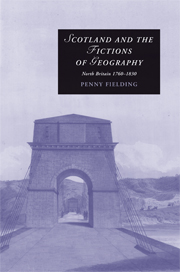Book contents
- Frontmatter
- Contents
- Acknowledgements
- Introduction
- 1 North Britain
- 2 Burns, place and language
- 3 Great North Roads: The geometries of the nation
- 4 Antiquarianism and the inscription of the nation
- 5 Ultima Thule: The limits of the north
- 6 Norths: James Hogg and post-Enlightenment space
- Notes
- Bibliography
- Index
- CAMBRIDGE STUDIES IN ROMANTICISM
3 - Great North Roads: The geometries of the nation
Published online by Cambridge University Press: 05 May 2010
- Frontmatter
- Contents
- Acknowledgements
- Introduction
- 1 North Britain
- 2 Burns, place and language
- 3 Great North Roads: The geometries of the nation
- 4 Antiquarianism and the inscription of the nation
- 5 Ultima Thule: The limits of the north
- 6 Norths: James Hogg and post-Enlightenment space
- Notes
- Bibliography
- Index
- CAMBRIDGE STUDIES IN ROMANTICISM
Summary
In 1787, an English traveller called Henry Skrine crossed the border from England to Scotland. His reaction was one of shock and disappointment at the apparent failure of history to perform its expected task of progressive improvement:
From the length of time, and the general intercourse of the nations since the Union, I was amazed to find such a wonderful change at once in the appearance of the people and their habitations. Instead of the healthy peasant, and the neat cottage, which adorn the most remote English villages, my eyes encountered, in a cluster of mud-built sheds, a number of miserable wretches, ragged, bare-footed, and squalid, almost beyond the power of description.
What is striking here is not the relatively commonplace eighteenth-century observation about Scottish working-class poverty, but Skrine's ‘amazed’ reaction, by the end of the century, to the apparent malfunction of progressive economic history, or what he calls the ‘general intercourse of the nations since the Union’. He encounters not only the question of where to locate Scotland in terms of spatial otherness or degrees of foreignness but also how to match the geographical with the chronological. The homogenising effects of smooth temporal development are interrupted by a ‘wonderful change’ laid bare by geography as time and space lose their synchronicity. What should have been a gradual change in time (from poverty to economic growth) is not supported but contradicted by a change in space (from England to Scotland).
- Type
- Chapter
- Information
- Scotland and the Fictions of GeographyNorth Britain 1760–1830, pp. 71 - 100Publisher: Cambridge University PressPrint publication year: 2008

